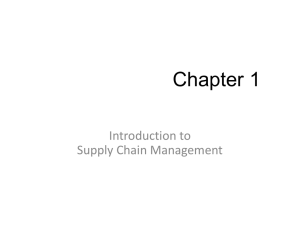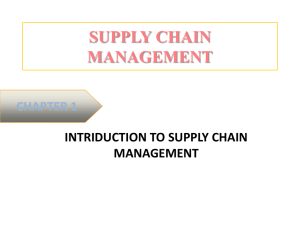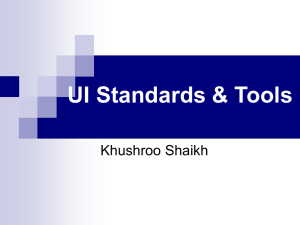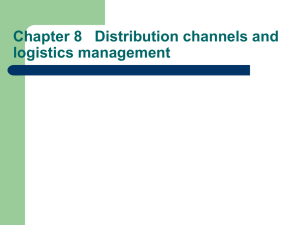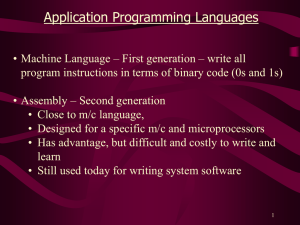Week 1: Introduction
advertisement
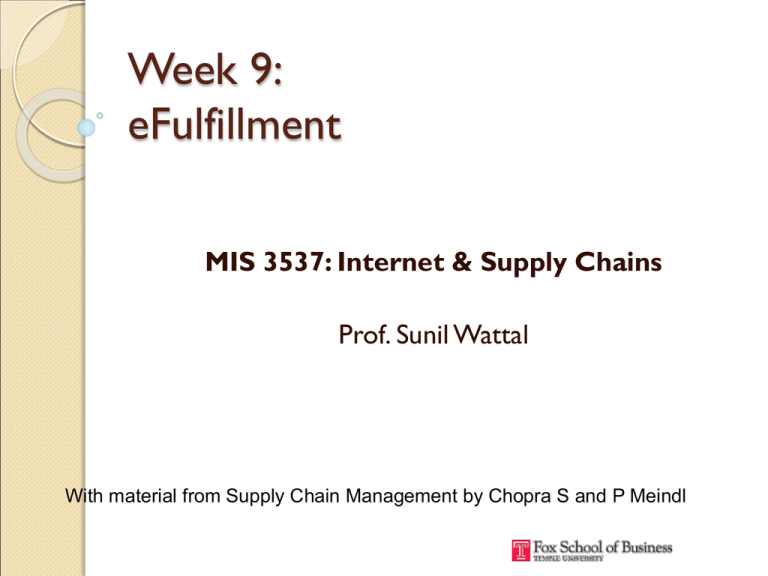
Week 9: eFulfillment MIS 3537: Internet & Supply Chains Prof. Sunil Wattal With material from Supply Chain Management by Chopra S and P Meindl Learning Objectives Understand the core eFulfillment principles Learn about various e-distribution strategies Designing Distribution Networks What is eFulfillment? Fulfillment = delivery Types of fulfillment ◦ Shop at a store ◦ Home-delivery ◦ Order online and pick up at store But eFulfillment is not just the delivery of goods or services online eFulfillment Set of distribution strategies ◦ Deliver faster ◦ Incur lowest possible cost Two core principles ◦ Improve the use of information ◦ Leverage existing resources Why eFulfillment? Living.com ◦ ◦ ◦ ◦ Online furniture retailer purchased a large furniture store Declared bankruptcy a year later Failure attributed to inability to deliver properly Reason: the furniture store was not organized to meet the online operations Furniture.com ◦ ◦ ◦ ◦ Launched in January 1999 Sales of $22 million in 2000 Folded due to poor logistics Single central warehouse, led to inefficient delivery and increased transportation costs ◦ Inability to manage regional distributors, especially repairs and returns Why eFulfillment? (contd.) Peapod ◦ First online grocer ◦ Taken over by Royal Ahold, in the face of mounting losses Other failed online grocery stores ◦ Shoplink.com, Streamline.com, WebHouse Club ◦ Reason: High delivery costs Why eFulfillment? (contd.) What differentiates Dell from the competition? ◦ Virtual integration ◦ The boundaries between suppliers, manufacturers and end users are blurred ◦ Holds eight days of inventory ◦ Produces to order ◦ No inventory of finished goods Value-added services Real-time inventory visibility & product availability Real-time package-tracking capability Real-time online payment approval Easily accessible customer service Multiple delivery options Real-time visibility of order status Single consolidated shipments Core principles Improve the use of information ◦ Logistics postponement ◦ Dematerialization Leverage existing resources ◦ Clicks and mortar (ship-to-store) ◦ Leveraged shipments Learning Objectives Understand the core eFulfillment principles Learn about various e-distribution strategies Designing Distribution Networks Logistics Postponement ◦ Merge in Transit ◦ Rolling Warehouse Dematerialization Resource Exchange Leveraged Shipments Click and Mortar Merge in transit Merge in Transit Merge in Transit (contd.) Merge in Transit (contd.) Rolling warehouse Merge-in-transit approach is used by: ◦ HP-Compaq, Menlo Logistics, Orient Overseas Container Line Rolling warehouse ◦ Products in a shipment are not pre-assigned to any destination ◦ Such information is passed to the fulfilling agent at delivery time ◦ Helps meet current demand Rolling warehouse (contd.) Dematerialization Material flow costs ◦ ◦ ◦ ◦ ◦ ◦ ◦ ◦ Handling Loading Unloading Warehousing Shipping Returns Spoilage Damage Dematerialization (contd.) Wherever possible, replace material flow with information flow Online greeting cards ◦ ◦ ◦ ◦ Most cards are free of cost Instant delivery No holding costs, inventory buildup Ability to offer value-added services Examples (contd.) Xilinx ◦ Semiconductor manufacturer makes fieldprogrammable circuits ◦ Circuits can be configured based on client needs Recruit Co. of Japan ◦ Used to publish seven-volume directory of job openings in Japan ◦ Today, no such paper directories are published ◦ Cost savings, ease of use, … Resource Exchange Resource Exchange (contd.) Resource Exchange (contd.) Only information flows between manufacturers A & B A & B acts as virtual sites for each other Used by Synchronet Marine, Tong Yang Major Corp. Cement Group Leveraged shipments When is the cost of delivery justified? ◦ If the order value is sufficiently large ◦ If there is a high concentration of orders in one area Delivery value density (DVD) DVD = Avg. total dollar volume of shipment / Avg. travel distance per trip Improving DVD The Streamline method ◦ Boston-based online grocer ◦ Delivery to specified neighborhoods on specified days of the week ◦ By accumulating deliveries, increased the total dollar volume of the shipment ◦ By focusing on specific neighborhoods, reduced the trip distance Improving DVD (contd.) The ECLine model ◦ Korean third-party LSP ◦ Recruited highly localized home-delivery service providers or dealers ◦ Dealers deliver multiple times daily (lower trip distance, because of localization) ◦ Excellent service benchmarks ◦ ECLine picks up items and drops off in bulk (lower DVD) Clicks-and-Mortar Model Get the customer to cover the last mile Customer orders online, and picks up the product at the nearest store Negligible incremental cost for the shipment Practiced by many companies, including WalMart, CVS, Ford Motors, … The right strategy Learning Objectives Understand the core eFulfillment principles Learn about various e-distribution strategies Designing Distribution Networks Factors Influencing Distribution Network Design Distribution network performance evaluated along two dimensions at the highest level: ◦ Customer needs that are met ◦ Cost of meeting customer needs Tradeoff between these two dimensions Factors Influencing Distribution Network Design Elements of customer service influenced by network structure: ◦ ◦ ◦ ◦ ◦ ◦ Response time Product variety Product availability Customer experience Order visibility Returnability Supply chain costs affected by network structure: ◦ ◦ ◦ ◦ Inventories Transportation Facilities and handling Information Service and Number of Facilities Number of Facilities Response Time Inventory Costs and Number of Facilities Inventory Costs Number of facilities Transportation Costs and Number of Facilities Transportation Costs Number of facilities Facility Costs and Number of Facilities Facility Costs Number of facilities Total Costs Related to Number of Facilities Total Costs Total Costs Facilities Inventory Transportatio n Number of Facilities Variation in Logistics Costs and Response Time with Number of Facilities Response Time Total Logistics Costs Number of Facilities Design Options for a Distribution Network Manufacturer Storage with Direct Shipping Distributor Storage with Carrier Delivery Distributor Storage with Last Mile Delivery Retail Storage with Consumer Pickup Manufacturer Storage with Direct Shipping Manufacturer Retailer Customers Product Flow Information Flow Distributor Storage with Carrier Delivery Factories Warehouse Storage by Distributor/Retailer Customers Product Flow Information Flow Distributor Storage with Last Mile Delivery Factories Distributor/Retailer Warehouse Customers Product Flow Information Flow Retail Storage with Customer Pickup Factories Retailer Cross Dock DC Pickup Sites Customers Customer Flow Product Flow Information Flow Optimal Distribution Network Strategy -> Scenario High Demand Retail Storage with Customer Pickup Manufactur e Storage with Direct Shipping High Product Value Low customer effort Distributor Storage with Last Mile Delivery √ Medium Demand Low Demand Distributor Storage with Carrier Delivery √ √ √ √ Questions!
